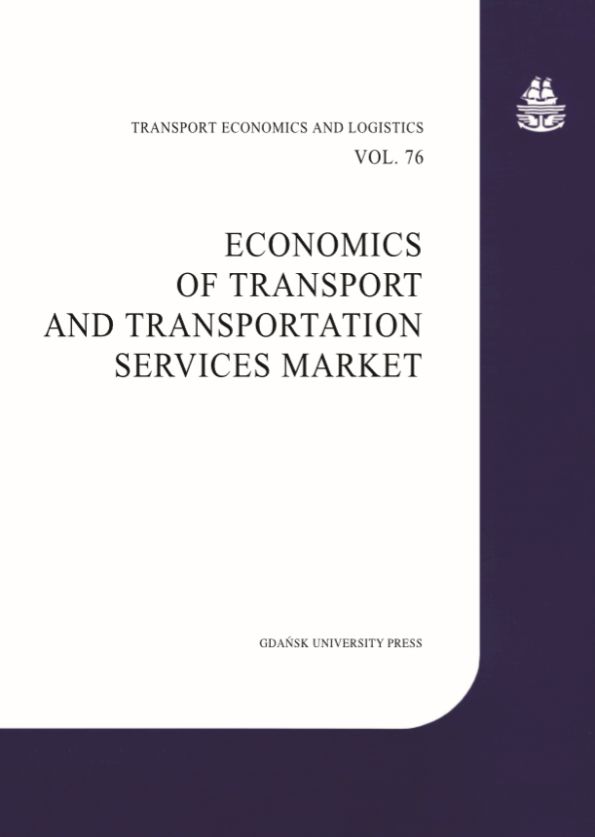Mathematical model for assessing the reliability of cargo delivery on the Caspian-Black sea route of the new Silk Road
DOI:
https://doi.org/10.26881/etil.2018.76.09Keywords:
new Silk Road, Caspian-Black sea route, mathematical model, reliability of cargo deliveryAbstract
The article analyzes possible options of goods delivery routes from China to EU countries through Ukraine. The most preferred route is presented in the form of a technological scheme consisting of five elements. In order to assess the reliability of cargo delivery on the Caspian-Black Sea Route, a mathematical model is considered. Presented model takes into account such linear parameters as the time of the cargo operation at the points of departure and destination, the vehicle transporting time on the corresponding element of the route, the average time of overload in junction points of rail and sea transport.
Downloads
References
Cfts.org.ua. (2018), Statistika – Tsentr transportnikh straregii, Available from http://cfts.org.ua/statistics [Accessed 14 March 2018].
Miecznikowski, S. and Radzikowski, T. (2017), Over Capacity Of Container Shipping as a Challenge to Rail Silk Road Competitiveness. Zeszyty Naukowe Uniwersytetu Gdańskiego, Ekonomika Transportu i Logistyka, 70.
Khanna, A. (2016), The new Silk Road is made of iron — and stretches from Scotland to Singapore. Available from https://www.paragkhanna.com/home/the-new-silk-road-is-made-of-iro-and-stretches-from-scotland-to-singapore [Accessed 13 March 2018].
Matsiuk, V. (2017), A study of the technological reliability of railway stations by an example of transit trains processing, Eastern–European Journal of Enterprise Technologies: Control processes, 1.
Me.gov.ua. (2017). Official website of the Ministry of Economic Development and Trade of Ukraine, Ukraina – Kytai: nastupnyi krok v realizatsii spilnoi initsiatyvy “Odyn poias – odynshliakh”(Ukraine-China: The Next Step in Implementing the Joint Initiative “One Belt – One Way”). Available from http://www.me.gov.ua/News/Detail?lang=uk-UA&id=92f5179e-dec8-43c4-bb34-fe7eb8e689f2&title=UkrainaKitai-NastupniiKrokVRealizatsiiSpilnoiInitsiativiodinPoiasOdinShliakh [Accessed 12 March 2018].
Novikova, A., Yurchenko, O. and Rudiuk, M. (2017), Ekonomiko-matematychna model Novoho Shovkovoho shliakhu zaliznychno-poromnoho spoluchennia cherez Ukrainu (Economic-mathematical model of the New Silk Road of railway-ferry connection through Ukraine), Avtoshliakhovyk Ukrainy, 1–2(249–250).
SeaRates (2018), Logistics Explorer. Available from https://www.searates.com/ru/reference/ portdistance/ [Accessed 13 March 2018].
Silin, Y., Kapustina, L., Trevisan, I. and Drevalev, A. (2017), China’s economic interests in the “One Belt, One Road” initiative, SHS Web of Conferences, 39.
Myronenko, V., Matsiuk, V., Vysotska, H. and Aleksiichuk, N. (2012), Modelyuvannya tranzytnykh transportnykh potokiv [Modeling of transit traffic flows], Avtoshlyakhovyk Ukrayiny, 6.
Serag, M. and Al-Tony, F. (2013), Modeling international freight transport through the ports and lands of Arab countries, Alexandria Engineering Journal, 52(3).
Šteinbuka, I., Muravska, T. andKuznieks, A. (2017), Cooperation Formats ofChina and Europe: Synergies and Divergences, Baltic Journal of European Studies, 7(1).

 Academic Scientific Journals
Academic Scientific Journals



